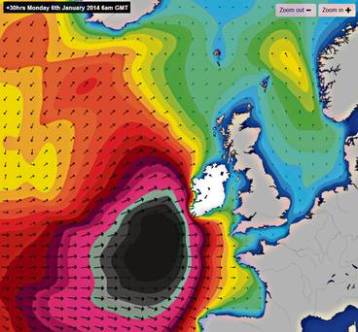In prediction version 1 (on air, Today FM and Radio Kerry), Ken Ring said:
3. “Mr. Ring says that 2014 will bring in bitter cold temperatures of -10ºC as the new year is rung in.”
4. Snow Jan 9th & 10th snow in midlands
In version 2 (in the comments on that linked post), Ken Ring widened his prediction:
3. 2014 could bring in cold temperatures of perhaps up to -10ºC in the north in the first 10 days of January.
4. Moderate snowfall possible (nothing is ever definite in weather forecasting) within a day or so of Jan 9th & 10th in midlands
Well, our most northerly weather station is Malin Head. You’ve to play around on this Met Éireann page, but you can select weather stations and dates. Malin Head, 1st Jan: a cool 3.2C, up to 7.2C. On the 2nd and 3rd – roughly the same. The 4th is a little cooler – it drops to nearly zero. But nowhere near -10 degrees centigrade. Zero for one.
So, snowfall. On the 9th or 10th. Or 7th, 8th, 9th, 10th, 11th or 12th, in the second “Whoops, someone took note!” predictions. But – we had no snowfall at all in the midlands. Or anywhere else. Zero for two. Under both sets of predictions.
I’ll also refer you again to this post, where the Auditor General states:
“For ice warnings and severe weather alerts, there are three possible outcomes which can be monitored
- a hit: where the forecasted weather actually occurs
- a miss: where the forecaster fails to predict an exceptional weather event
- a false alarm: where adverse weather is forecast but fails to materialise.”
This seems a fair way to measure predictions. You’d imagine that the most severe storms to hit Ireland in years might have merited a mention from Mr Ring when he was talking to Matt Cooper, but nope – not a dickie bird about storms.
January’s Storm Christine, by the way, is estimated to have cost in the region of €300 million in damages. I’d call that a miss.
But, in fairness, we never said we’d measure misses, so we won’t count those. (Although, despite claiming to have predicted the Christchurch earthquake, there’s nothing on Mr Ring’s site at all about today’s 6.2 magnitude earthquake on New Zealand’s North Island, either. There’s a lot about climate change denial, though.)

